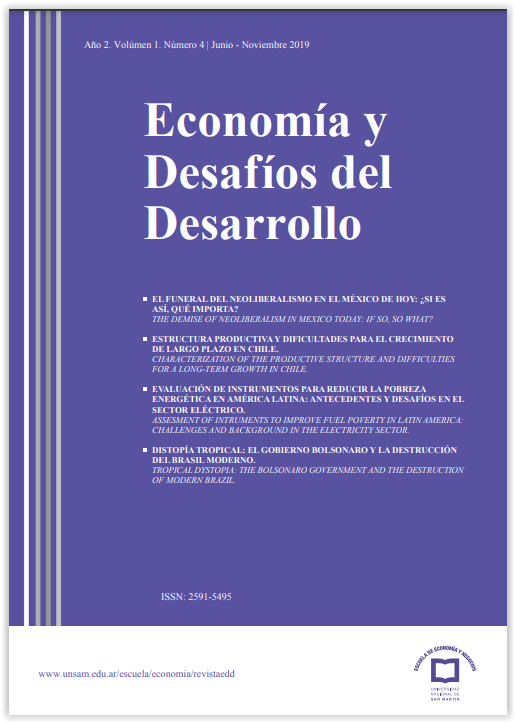Characterization of the productive structure and difficulties for a long-term growth in Chile
Keywords:
Long-term growth, extractivism, role of the State, productivity, heterodox economyAbstract
This paper develops the main characteristics of the Chilean economy to identify the critical knots that it presents for its sustainable development, with main emphasis on the role of the State within the economy.
The last decades have seen how the State has lost importance in the productive process and with it, a productive matrix has been configured to extract natural resources and produce low sophistication goods. The document illustrates how this last idea has been expressed in stagnation in productivity and in the diversification of exports.
The document is part of the series of works in the area of Productive Development Policies of the Observatory of Economic Policies (OPES), a center of economic thought in Chile with heterodox profile that performs applied research and dissemination focused on the development and implementation of policies public.
References
Abeles, M; Arakaki, A. y Villafañe, Soledad. (2017). Distribución funcional del ingreso en América Latina desde una perspectiva sectorial. Estudios y perspectivas, Serie 53. CEPAL.
Accorsi,S; Figueroa, E; López, R. y Sturla, G. (2016). Nuevas estimaciones de la riqueza regalada a las grandes empresas de la minería privada del cobre: Chile 2005-2015. Serie de Documentos
de Trabajo N°435, Departamento de Economía, Universidad de Chile.
Agosin, M. (2009). Crecimiento y diversificación de exportaciones en economías emergentes. Revista CEPAL N°97.
Albagli, E. y Naudon, A. (2015). ¿De qué hablamos cuando hablamos de producto potencial? Banco Central de Chile.
Crespi, G., Katz, J. y Olivari, J. (2016). Innovación, actividades basadas en recursos naturales y cambio estructural: la emergencia de empresas de servicios intensivos en conocimiento. La política
de innovación en América Latina y el Caribe, BID.
CEPAL (2015). Neoestructuralismo y corrientes heterodoxas en América Latina y el Caribe a inicios del siglo XXI, Santiago de Chile.
CEPAL (2017). La Inversión Extranjera Directa en América Latina y el Caribe 2017, Santiago de Chile.
Ffrench-Davis, R. (2007). Desarrollo Económico en Chile: Desafíos hacia el bicentenario. Serie Documentos de Trabajo N° 270, Departamento de Economía, Universidad de Chile.
Ffrench-Davis, R. (2010). Macroeconomía para el desarrollo: desde el “financierismo” al “productivismo”. Revista CEPAL N°102.
Ffrench-Davis, R. (2014). Chile entre el Neoliberalismo y el crecimiento con equidad. Cuarenta años de políticas económicas y sus lecciones para el futuro. Quinta Edición.
Ffrench-Davis, R. (2016). La experiencia de Chile con el balance fiscal estructural. Cuadernos de Economía, 35(67), 149-171.
Ffrench-Davis, R. (2016). Depreciación del Capital Físico, Inversión Neta y Producto Interno Neto. Serie de Documentos de Trabajo N°425, Departamento de Economía, Universidad de Chile.
Frenkel, R. y Rapetti, M. (2011). Fragilidad externa o desindustrialización: ¿Cuál es la principal amenaza para América Latina en la próxima década? Macroeconomía para el desarrollo, Serie 116, División de Desarrollo Económico, CEPAL.
Furtado, C (2003). En busca de un nuevo modelo: reflexiones sobre la crisis contemporánea, México, D.F., Fondo de Cultura Económica.
Hausmann, R., Hwang, J. y Rodrik, D. (2006). What you export matters. Journal of Economic Growth.
Katz, J. (2006). Cambio estructural y capacidad tecnológica loca. Revista CEPAL N° 98.
Krugman, P. (1987). “The narrow moving band, the Dutch disease, and the competitive consequences of Mrs. Thatcher: Notes on trade in the presence of dynamic scale economies”. Journal of Development Economics, 27, 41.55.
Meller, P. y Moser, R. (2012). Rol de los TLCs y el patrón exportador chileno. CIEPLAN.
Minsky, H (1986). Stabilizing an unstable economy, New Haven, Yale University Press.
Minsky, H (1982). Can “it” happen again? Nueva York, M.E. Sharpe.
Ros, J. y P. Skott (1998) “Dynamic effects of trade liberalization and currency overvaluation under conditions of increasing returns”, The Manchester School of Economic and Social Studies, 66 (4), 466.89.
Sachs, J. y Warner, A. (2001) “The Natural Resource Curse”, European Economic Review, Vol. 45, Issue 4-6, pp. 827-838.



